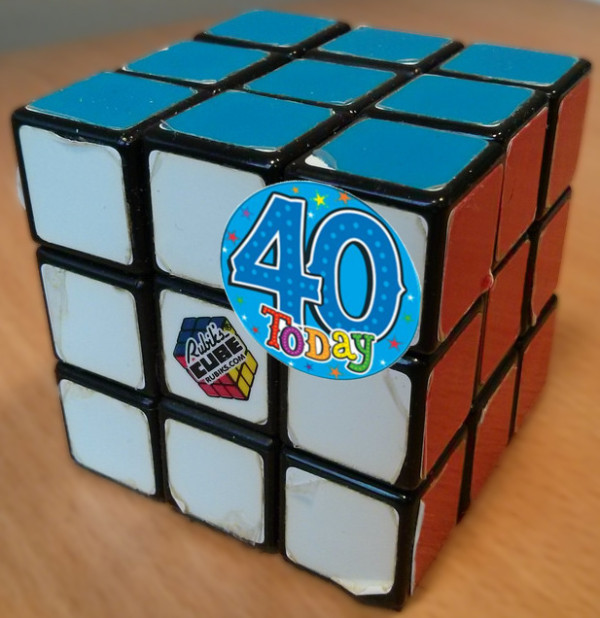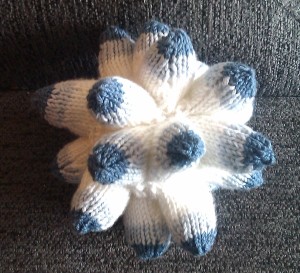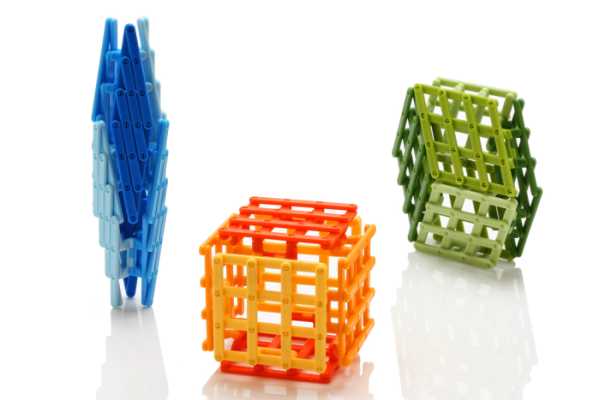Looking for small/inexpensive items to put inside a piece of festive footwear (or, to keep for yourself)? Here’s a selection of things we’ve seen lately that you might want to buy! All the items we’re showing are under £20, and range from slightly mathematical to very mathematical.
You're reading: Posts Tagged: toys
Zeckendorf cup arithmetic
My 5-minute talk at the big MathsJam conference this weekend was about some stacking cups that my daughter is too young to appreciate. Here’s the really quick version, in just over a minute:
I gave the answer at MathsJam, but the title of this post contains a big hint that should get you there with a bit of googling.
Rubik’s Cube is 40 years old

Invented in 1974, patented in 1975 and released for sale in Hungary in 1977, Rubik’s Cube could certainly be considered to have reached its 40th birthday this year. To celebrate, inventor Ernő Rubik has helped put together a special exhibition at Liberty Science Centre, New Jersey, celebrating the history of the hexahedral enigma. The exhibition, called ‘Beyond Rubik’s Cube’, opens on 26th April for several months.
The Magic Cube – a 3D logic puzzle
A chap called Jonathan Kinlay has innovented a Rubik’s cube variant which only has one colour, but six different integer sequences on its sides. As a colourblind integer sequence enthusiast, this basically has to be my ideal Christmas present, right?
Well, it’s currently looking for funding on Kickstarter in advance of actually existing, and the first units won’t be delivered before Christmas, but it’s a fun idea anyway.
3D-printed mathematical objects roundup
3D printers are ace. People are using them to make all sorts of cool things. If you can describe a shape to a computer, it’s very easy to send that description to a 3D printer, which will happily smoosh some substrates together to make a real model of your shape. Mathematicians are able to describe all sorts of crazy shapes, in exactly the amount of detail computers need, so they’ve taken to 3D printing like ducks to water.
Thingiverse is just a repository for designs, so if you see something you like you’ll have to find your own 3D printer. Shapeways makes the objects and posts them to you; prices can vary from just a few euros to hundreds, depending on the size of the object and the materials used.
As with all other kinds of mathematical art, there’s a huge amount of repetition of the same few ideas, but also a few really interesting and unique designs. I’ve picked a couple of representatives from each of the popular topics, but do search around if you want a version with slightly different parameters; you’re bound to find something suitable.
For the past few months I’ve been quietly compiling a list of interesting mathematical objects I’ve found on the main 3D printing catalogues, Thingiverse and Shapeways. With Christmas approaching, I thought now would be as good a time as any to share what I’ve found.
Prismatoy: a parallelepiped you can hold
Applied mathematicians love parallelepipeds. The one I share my office with is always drawing them, and banging on about how great they are. Well, I think I know just what to get him for Christmas.
Hopson Kinetic has, for reasons only they can know, made a plastic parallelepiped toy called Prismatoy. It’s constructed from “72 individual jointed parts” and is roughly the size of a stack of floppy disks. The slogan is, “What shapes will you find?” Without having played with one, I’m going to go with “a variously sheared cube”.
It’s $14.99, and comes in orange, green or blue flavours. The site says “international shipping is currently unavailable”, which I assume means they won’t deliver outside the US.
Online shop: Hopson Kinetic
Knitted Spiky Icosahedron
 As an avid knitter, and mathematician, the birth of a small human in my family inspired me to create a mathematical toy for the tiny person to enjoy while learning about shapes. With my favourite platonic solid being the icosahedron, it was the obvious choice for a knitted toy, and with stellation being all the rage, sticking a point on each face was the obvious next step, especially when it’s such a convenient thing for tiny inexperienced hands to grasp.
As an avid knitter, and mathematician, the birth of a small human in my family inspired me to create a mathematical toy for the tiny person to enjoy while learning about shapes. With my favourite platonic solid being the icosahedron, it was the obvious choice for a knitted toy, and with stellation being all the rage, sticking a point on each face was the obvious next step, especially when it’s such a convenient thing for tiny inexperienced hands to grasp.
